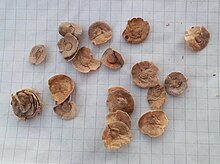Pterocactus
| Pterocactus | ||||||||||||
|---|---|---|---|---|---|---|---|---|---|---|---|---|

Pterocactus tuberosus , flowers |
||||||||||||
| Systematics | ||||||||||||
|
||||||||||||
| Scientific name of the tribe | ||||||||||||
| Pterocacteae | ||||||||||||
| Doweld | ||||||||||||
| Scientific name of the genus | ||||||||||||
| Pterocactus | ||||||||||||
| K. Schum. |
Pterocactus is a genus of plants inthe cactus family (Cactaceae). It is the only genus in the tribe Pterocacteae in the subfamily Opuntioideae . Its botanical name is derived from the Greek noun "πτερόν" ("ptero") for "wings" and refers to the winged seeds that are typical of the genus and unique within the cactus family.
description
The dwarf, succulent plants of the genus grow largely underground as geophytes . The tuberous roots form one or more underground shoots, which are often provided with thin, neck-like constrictions. These underground shoots branch out just below the surface and form short-lived above-ground shoots. The small, spherical to club-shaped or cylindrical shoot segments are green to brown or purple in color and are up to 10 centimeters long and 2 centimeters in diameter. They often have a papillate surface. The small and awkward leaf rudiments fall off quickly. The few, needle-like, sub-like or paper-like thorns sit together with the glochids on the areoles . The terminal and individually appearing flowers are sunk into the tip of the shoots. They are usually yellow or reddish and about 3 to 5 centimeters in diameter. The slightly tuberous pericarpel is covered with tufts of small thorns, the stamens are sensitive to touch.
The dry fruits are sunk like a navel at the tip and tear open like a lid near the tip. The winged seed is more or less circular, light beige and paper-like. The aril is designed as a broad wing.
Systematics and distribution
The species of the genus are distributed throughout Argentina and are also found in southern Chile . The main distribution area is in the south and west of Patagonia .
The first description was published in 1887 by Karl Moritz Schumann . He chose Pterocactus kuntzei as the type species . Due to morphological peculiarities, Alexander Borissovitch Doweld put it in 1999 as the only genus in the tribe Pterocacteae created by him. The taxonomic position of the genus Pterocactus within the subfamily Opuntioideae is undisputed. Molecular genetic studies show that the genus is monophyletic .
The genus includes the following species:
- Pterocactus araucanus A. Cast
- Pterocactus australis (FACWeber) Backeb.
- Pterocactus fischeri Britton & Rose
- Pterocactus gonjianii R. Kiesling
- Pterocactus hickenii Britton & Rose
- Pterocactus megliolii R. Kiesling
- Pterocactus reticulatus R. Kiesling
- Pterocactus tuberosus (Pfeiff.) Britton & Rose
- Pterocactus valentinii Speg.
proof
literature
- Walther Haage : Cacti from A to Z , 1981.
- Roberto Kiesling: The genus Pterocactus . In: Cactus and Succulent Journal of Great Britain . Volume 44, Number 3, 1982, pp. 51-56.
- Edward F. Anderson : The Great Cactus Lexicon . Eugen Ulmer KG, Stuttgart 2005, ISBN 3-8001-4573-1 , p. 552-555 .
Individual evidence
- ↑ K. Schumann: New cacti from the Andean region . In: Monthly for cactus science . Volume 7, number 1, 1897, p. 6 ( online ).
- ↑ Succulent . Volume 1, Number 2, 1999, p. 26.
- ↑ M. Patrick Griffith, J. Mark Porter: Phylogeny of Opuntioideae (Cactaceae) . In: International Journal of Plant Sciences . Volume 170, No. 1, pp. 107-116, Chicago 2009, doi : 10.1086 / 593048
further reading
- A. Faigón, BG Galati, S. Rosenfeldt, R. Kiesling: Epidermal Characters of Pterocactus (Opuntioideae, Cactaceae) . In: Haseltonia . Volume 16, 2011, pp. 57-66, DOI: 10.2985 / 1070-0048-16.1.57 .
Web links
- www.pterocactus.de - Information on the genus
- Pterocactus at Tephroweb

